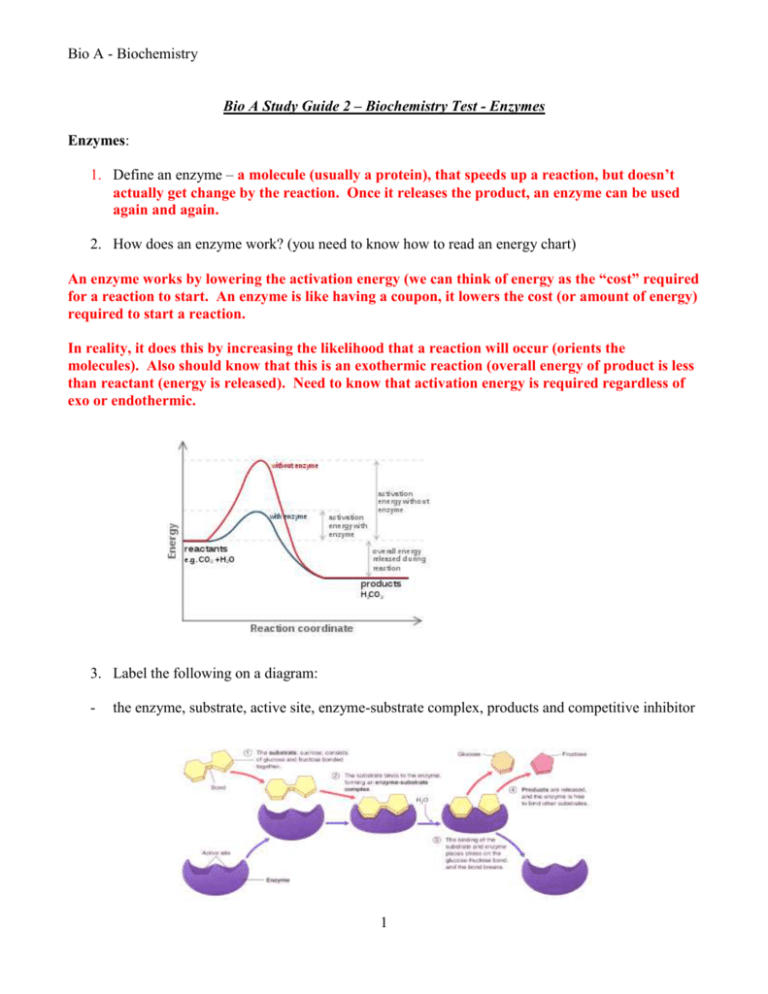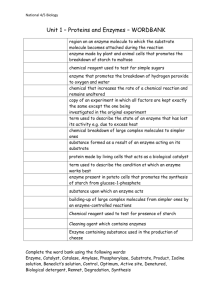(Enzyme Study Guide) ANSWERS
advertisement

Bio A - Biochemistry Bio A Study Guide 2 – Biochemistry Test - Enzymes Enzymes: 1. Define an enzyme – a molecule (usually a protein), that speeds up a reaction, but doesn’t actually get change by the reaction. Once it releases the product, an enzyme can be used again and again. 2. How does an enzyme work? (you need to know how to read an energy chart) An enzyme works by lowering the activation energy (we can think of energy as the “cost” required for a reaction to start. An enzyme is like having a coupon, it lowers the cost (or amount of energy) required to start a reaction. In reality, it does this by increasing the likelihood that a reaction will occur (orients the molecules). Also should know that this is an exothermic reaction (overall energy of product is less than reactant (energy is released). Need to know that activation energy is required regardless of exo or endothermic. 3. Label the following on a diagram: - the enzyme, substrate, active site, enzyme-substrate complex, products and competitive inhibitor 1 Bio A - Biochemistry 4. What does it mean to say that enzymes have specificity? Why can they only affect one specific kind of reaction? One enzyme can only work on one substrate (and cannot reverse the reaction) Sucrase works on sucrose and breaks it down to glucose and fructose. It cannot put glucose and fructose back together again. 5. Discuss the following a. What is a substrate? How does the amount (concentration) of substrate affect the speed of a reaction? The molecule that is the reactant in the equation and that is being changed. For a given enzyme concentration, as the concentration of substrate (reactant) increases, enzyme activity (the rate of change of substrate to product) will increase, until all the enzyme molecules are “busy”. Then the activity (rate of reaction) will continue at a constant rate even if the amount of substrate increases b. How does the amount of enzyme affect the speed of a reaction? Now we assume we have a “constant” supply of substrate (reactant). That means as fast as we turn it into prouct, more of it shows up. This time the amount of enzyme is increasing, so our graph will look like c. What does the word “optimal” mean? If you are not at an optimal pH (either too high or too low), what can happen to the enzyme? Optimal means “best”. If you are at an optimal pH, the reaction will go at it’s fastest rate.. Many enzymes works within a small pH range. There is a pH at which its activity is greatest (the optimal pH). This is because changes in pH can make and break intra- and intermolecular bonds, changing the shape of the enzyme and, therefore, its effectiveness. 2 Bio A - Biochemistry d. can an enzyme have an optimal pH that is NOT at pH 7? What do you think the optimal pH of an enzyme in the stomach (like pepsin). Different enzymes have different “optimal pH”. Optimal is the “best”, it can be low (like in the stomach) or it can be higher (like in the small intestine) e. Low temperatures will slow the reaction rate of an enzyme, but will not harm the enzyme. How is this different that heating an enzyme above its’ optimal temperature? . There is a certain temperature at which an enzyme's activity is at its greatest (see graph). This optimal temperature is usually around human body temperature (37.5 oC) for the enzymes in human cells. Above this temperature the enzyme structure begins to break down (denature) since at higher temperatures intra- and intermolecular bonds are broken as the enzyme molecules gain even more kinetic energy. Inhibition An inhibitor is a molecule that can bind to the active site and prevents a substrate from binding to the active site. Competitive inhibitors compete with the substrate to “sit” in the site. This decreases enzyme availability, and decreases or stops the reaction Non-competitive inhibition is when a molecule binds to a site on the molecule other than the active site. This molecule changes the shape of the active site when it binds and substrate can no longer “fit” in the active site. 3 Bio A - Biochemistry Example Enzyme Questions: You have an enzyme that is supposed to have a particular shape, but instead is deformed. 6. What is the vocabulary word for the “deformed” enzyme? 7. Identify two things that could have caused your enzyme to change shape. 8. Will the enzyme still work in the deformed shape? Why or why not? 1. Identify one way to shut off an enzyme without changing the shape? 2. Let’s say that lactose requires 500 units of energy to break into glucose and galactose without an enzyme. If we added an enzyme to this reaction, would it still take 500 units of energy to change lactose into its products? Why or why not? USE YOUR VOCAB! 4









